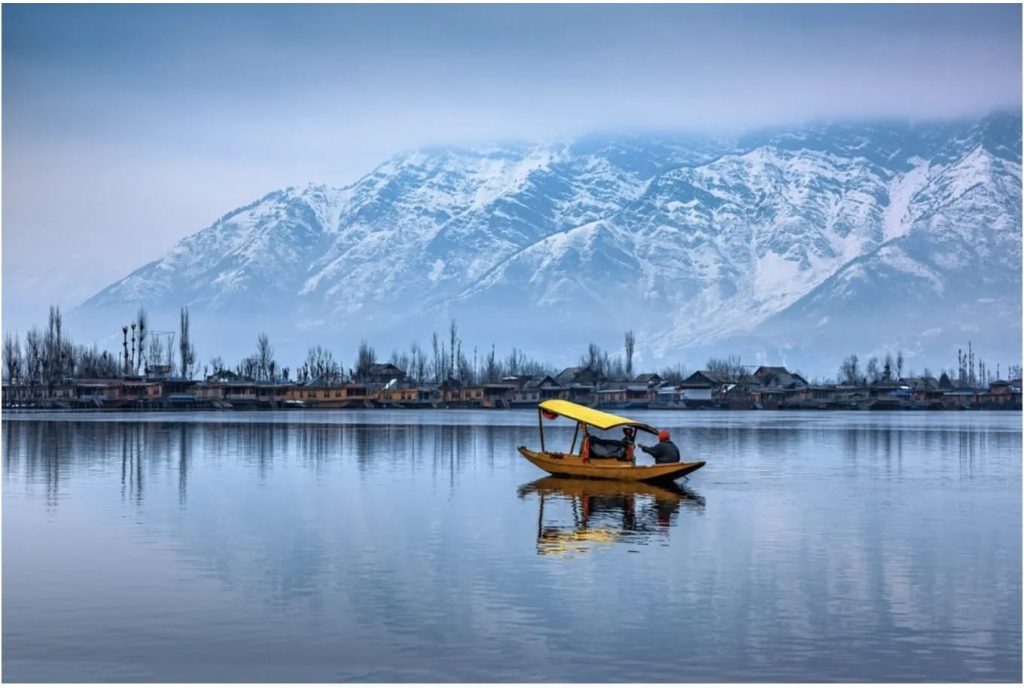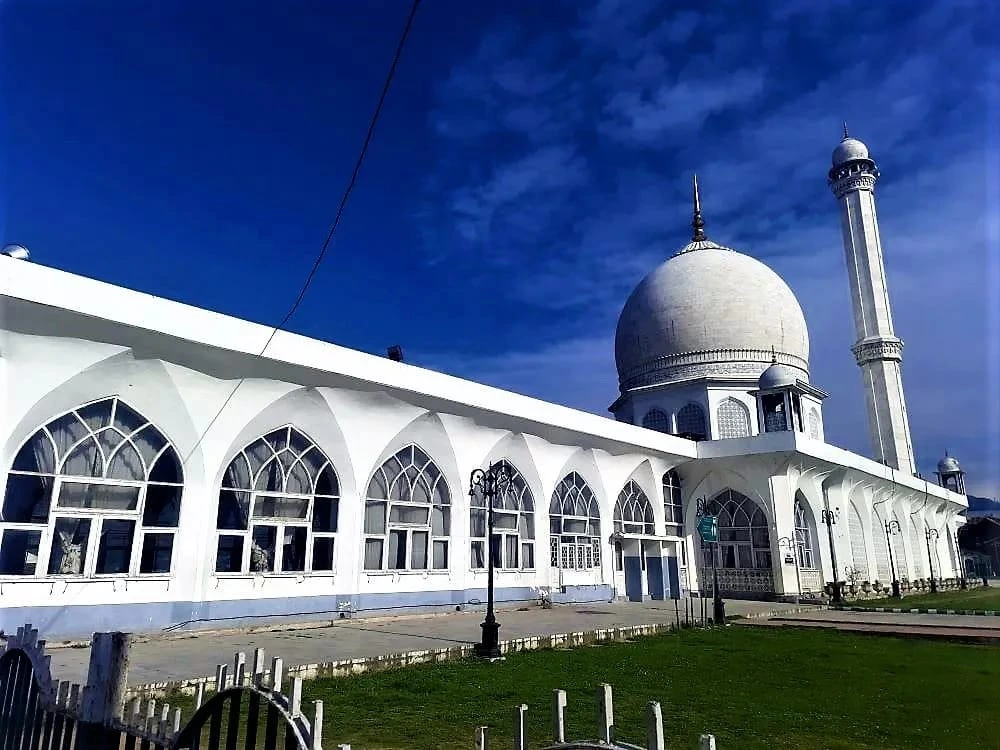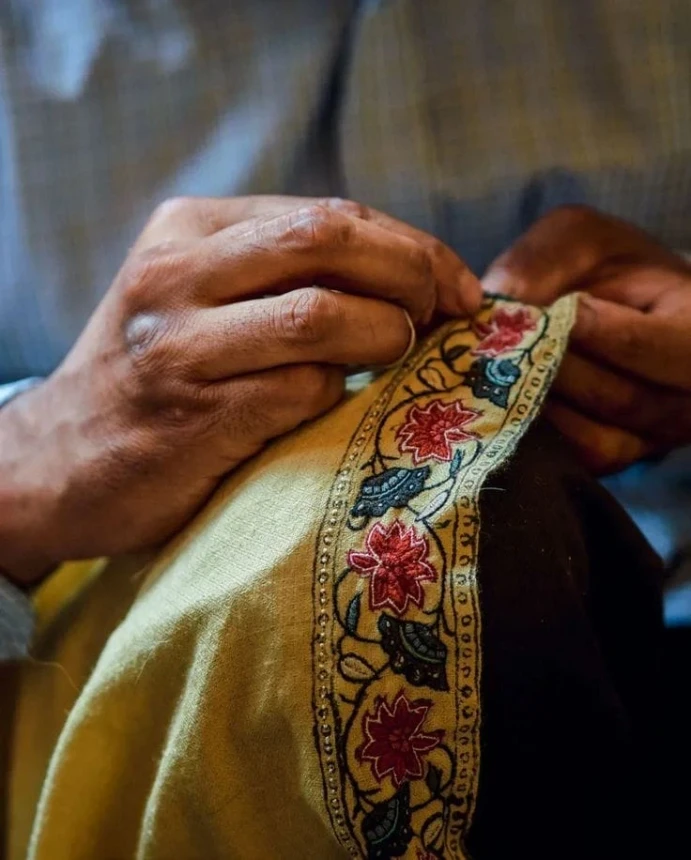The Kashmir region is predominantly mountainous, with deep, narrow valleys and high, barren plateaus. The relatively low-lying Jammu and Poonch plains in the southwest are separated by the thickly forested Himalayan foothills and the Pir Panjal Range of the Lesser Himalayas from the larger, more fertile, and more heavily populated Vale of Kashmir to the north.
The vale, situated at an elevation of about 5,300 feet (1,600 meters), constitutes the basin of the upper Jhelum River and contains the city of Srinagar. Jammu and the vale lie in Indian-administered Jammu and Kashmir, while the Poonch lowlands are largely in Pakistan-administered Kashmir. There is no iota of doubt that Kashmir has a heritage of rich culture.
If religion plays a pivotal role in contributing to the cultural richness of the Kashmir valley, the linguistic culture adds finesse to it. According to Sir George Grierson, a renowned linguistic scholar, the Kashmiri language was developed in Dardistan, the region between North West of Punjab and the Pamir. Barring Arabic, Persian, and Sanskrit words, the remaining words of the language are Dardic or Paschachi. Gierson adds that ‘’Kashmiri has immensely and for centuries been influenced by Sanskrit.”
History Of Kashmir And Its Cultural Roots:
The archaeological evidence available from Kashmir is a rich source for reconstructing the history of ancient and early medieval Kashmir. The earliest monumental Remains of the historical period have been reported from Harwan and are dated from the 3rd to the 6th centuries AD. Harwan is a prominent site where buildings and terracotta tiles have been excavated. These tiles reveal certain. The archaeological remains of temples constructed during the reign period of Lalitaditya have been reported. Of these, the majestic ruins of the Sun Temple at Martanda represent the glory and splendour of this period.
Several sculptural remains have also been reported. The remains at Avantipura are a fine example of the architectural achievements of the reign of Avantivarman. Talking of Kashmir, everyone heaps praise on its postcard-worthy scenery, its houseboats and apple trees, but not much is known about its syncretic traditions of sacred architecture.
The region has long been a melting pot of cultural practices that include Hinduism, Buddhism, and Islam. The 14th century, in particular, is considered a watershed in Kashmir’s history, when different traditions of art and architecture came together — this can be seen, for example, in the ubiquitous pagoda-style construction of mosques such as Khanqah-i-Maulla (Great Khanqah) or Madin Sahab.
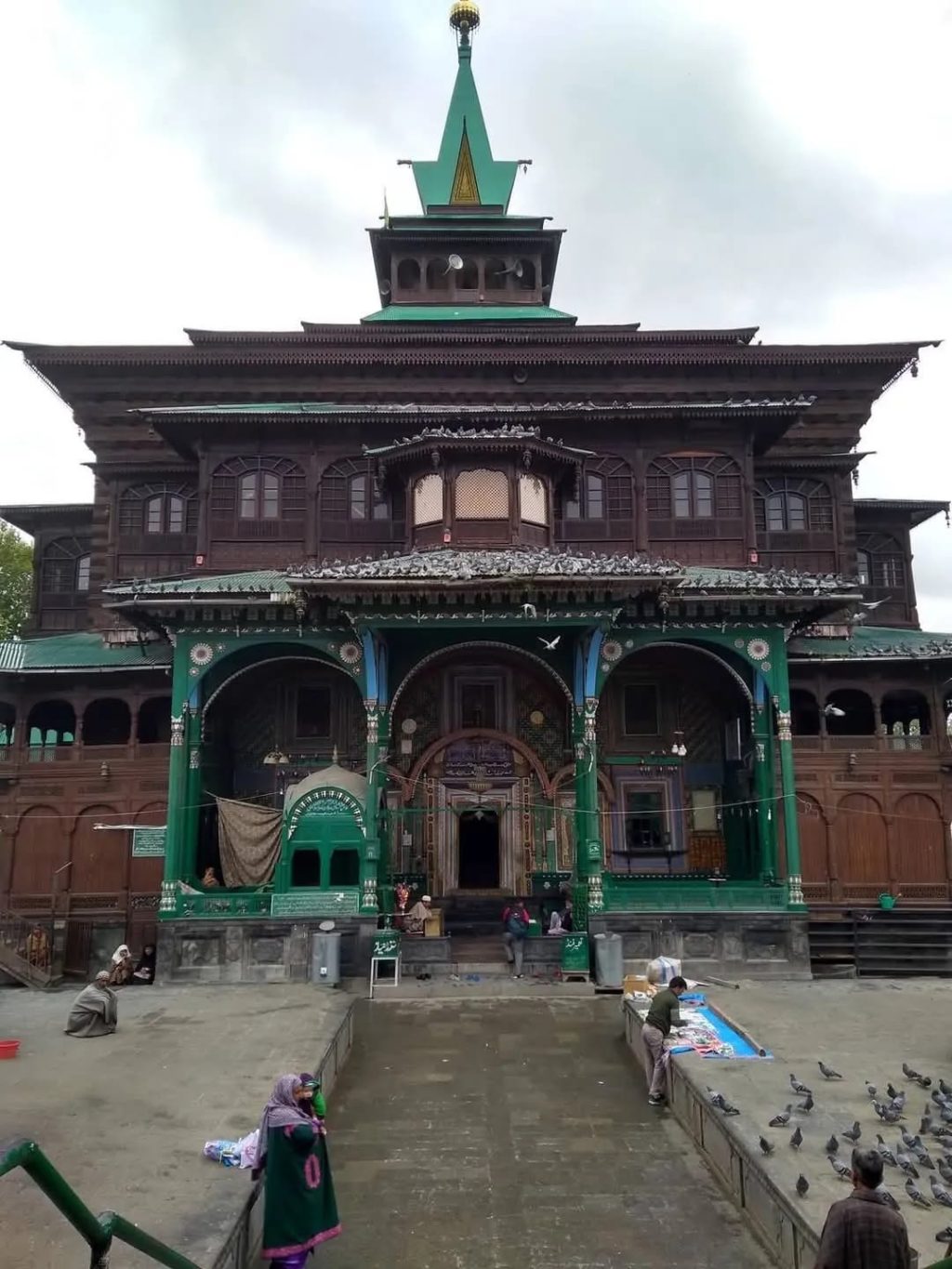
Traditional Kashmiri Attire jewelry:
The Jammu and Kashmir traditional dress is renowned for its intricate embroidery and detailed patterns, showcasing the rich culture and landscapes of the region. This traditional clothing is carefully crafted to combat the cold climate.
The most commonly worn outfit for both men and women is the “Pheran,” a long, loose gown that extends below the knees. Pherans are crafted from various materials, including wool, silk, and cotton, chosen based on status and weather conditions. Women in Kashmir also don the “Pheran,” a prominent garment paired with a variety of skull caps and headgear in diverse styles.
Their headpieces consist of a vibrant, stitched scarf called “Taranga,” fastened to a suspended cap, narrowing down towards the heels. Tradition and culture are the essence of Jammu and Kashmir- from its poetry to its cuisine to its distinctive fashion.
The state’s rich heritage is reflected in the enchanting Kashmiri gold jewellery that is known for its intricate, well-crafted designs and unique and minute detailing. And their names are derived from the Persian and Sanskrit languages.
The Mughal Queen Noor Jehan is credited with introducing and influencing the intricate variety of jewellery in Kashmir. The native artisans of Kashmir are exceptionally talented in the art of jewellery-making. Their techniques are old and traditional, and considered impossible to recreate.
Jiggni-Kashmiri Jewellery
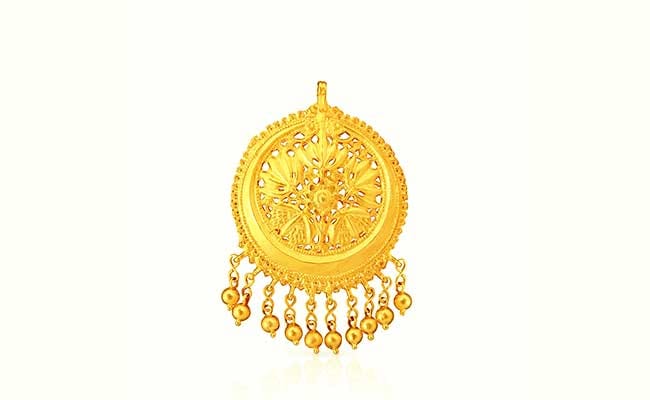
This ornament is worn on the forehead. It is made of gold and is fringed with hanging pearls and gold leaves. It is usually triangular, semi-circular, or circular.
Halqaband-Kashmiri Gold Jewellery
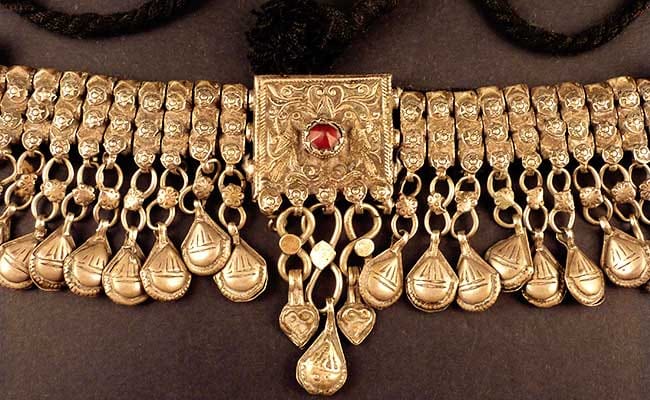
A traditional tight choker, the halqaband is worn around the neck. It is usually made of gold and has interlocking sections joined together with thread.
Dejihor-Gold Kashmiri Earrings

Every Pandit woman wears the dehiya as a symbol of her marriage. It is a dangler earring that hangs from the upper portion of the ear. The great Kashmiri acharyas believed it was designed to infuse divine strength in married women.
Atta-hor-Gold Kashmiri Jewellery
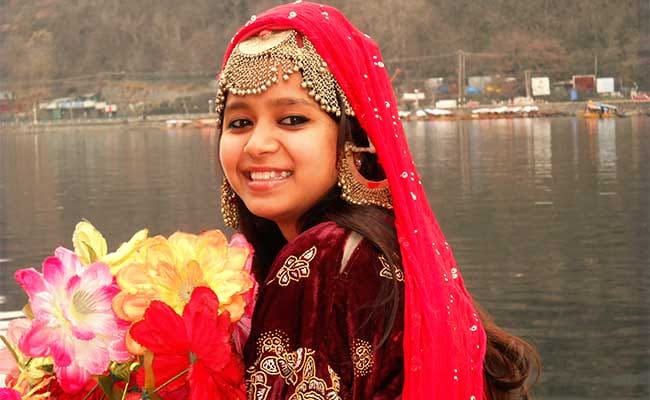
Another ornament worn by married Kashmiri Pandit women, atta-hor hangs over both ears and is connected by a gold chain over the head.
Kana-Door-Traditional Kashmiri Earrings
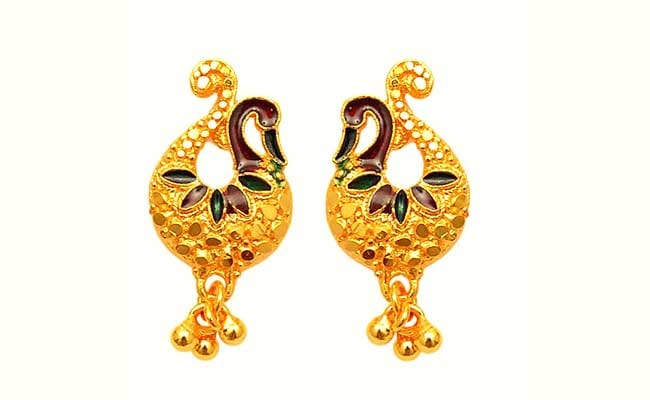
More popular among younger women, kana-door is also a piece of jewellery for the ear. Made of gold and studded with red or green pearls, kana-door also refers to ‘beloved’ in Kashmiri poetry.
Gunus- Gold Kashmiri Bangles
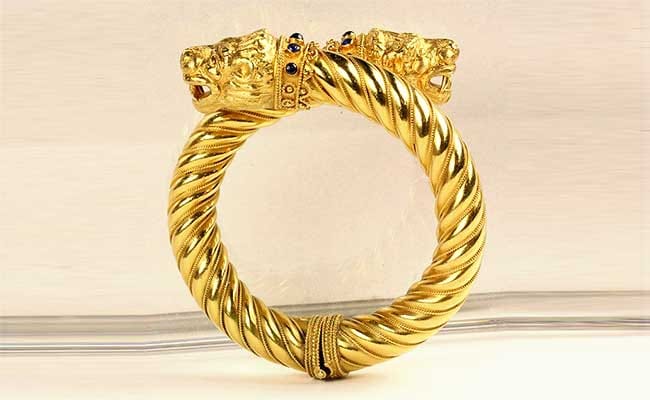
An ornament for the wrist, gunus is a thick gold bangle and has the head of a snake or a lion at both ends. This design is one of many gold designs inspired by wildlife.
Kashmiri Gold Maang Tika
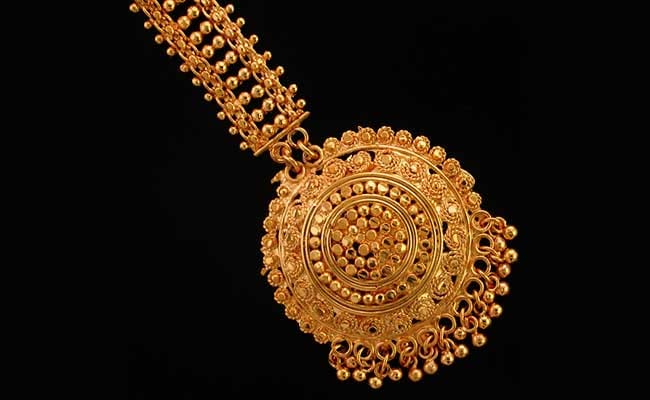
When it comes to bridal jewellery, a gold maang-tika (or just tika) is another ornament that’s worn on the forehead. Brides also wear a kada or bangle, made of fine gold filigree work, on their wrists.
Exploring The Rich Flavors Of Kashmiri Cuisine
Kashmiri cuisine is predominantly non-vegetarian, but it also has some exquisite vegetarian dishes. Rice is a staple in Kashmiri cuisine. Kashmir is one of the largest producers of saffron in the world, therefore, saffron is commonly added to many dishes. Kashmiri cuisine is known for its use of spices such as fennel seeds, cinnamon, cardamom, cloves, and Kashmiri red chili powder, which adds a vibrant red color without the intense heat found in other Indian cuisines.
Kashmir’s fragrant Elixir
In Kashmir, kahwa is not just a drink; it represents friendliness and warmth. This traditional Kashmiri green tea is made with saffron, almonds, and various spices that enhance its taste. It is a staple in Kashmiri households. The famous food of Kashmir pairs well with a hot cup of kahwa. It’s also a great way to start or finish a meal.
Harissa Kashmiri Comfort Food
This is Kashmir’s famous dish, which is loved by the Kashmiri people, especially during winters. Slowly cooking mutton and a mix of spices results in a rich and creamy texture for this filling meat porridge. Harissa is a wonderful example of Kashmiri cuisine because it makes every bite feel cozy and warm. Ingredients and Methods: To make harissa, cook cardamom, fennel, cloves, and rice slowly with a lot of ghee (clarified butter). This is a very time-consuming process. Until the mixture has a thick and smooth consistency, we stir it repeatedly.
Kashmiri Wazwan
Famous Food of Kashmir. It wouldn’t be a discussion on Kashmiri cuisine without including Wazwan. Customarily served at weddings and other special occasions, this sumptuous feast comprises multiple courses expertly prepared by skilled chefs known as Wazas. With a diverse array of flavors and textures, the Wazwan is a true celebration of Kashmir’s famous food.Main Dishes at Wazwan are Rogan Josh, Tabak maaz, Gushtaba & Rista, Yakhni and Dum Aloo.
Festivals And Celebrations In Kashmiri Culture
Kashmir, with its rich cultural tapestry, celebrates a myriad of festivals that blend religious traditions with communal harmony. One of the grandest celebrations is Eid al-Fitr, marking the end of Ramadan. The vibrant atmosphere is filled with prayers, feasts, and the exchange of warm greetings, bringing together people from diverse backgrounds in a spirit of unity and joy.
Eid-ul-Adha is to commemorate Prophet Ibrahim’s devotion to Allah SWT and his readiness to sacrifice his son, Ismail. At the very point of sacrifice, Allah SWT replaced Ismail with a ram, which was to be slaughtered in place of his son. This command from Allah SWT was a test of Prophet Ibrahim’s willingness and commitment to obey his Lord’s command, without question. Therefore, Eid-ul-Adha means the festival of sacrifice.
Kashmiri Pandits celebrated the annual festival of ‘Herath’ or Maha Shivaratri in the Valley on Friday. Scores of Muslims from the Valley also joined in to wish the Pandits on the occasion. Pandits were seen busy with the festivities on Friday. Special pujas were held at Shankaracharya temple in Srinagar and the Kheer Bhawani temple in Ganderbal.“As per our tradition, we celebrate Herath, which means ‘Har Rati’, in our respective homes. Puja starts after sunset till midnight.

Shivratri is the most important of our festivals, lasting for a full week in the month of Phalguna. It is also known as Herath among Kashmiri Pandits, a phonetic derivative of Har-ratri, the night of Hara (Shiva). It is a socio-religious function that is ingrained in the daily lives of Kashmiri people. Every Kashmiri female is considered a Parvati who is married to Shiva.
Navreh is an important Kashmiri festival, celebrated by Kashmiri Pandits as the New Year with all delight and freshness. It is dedicated to their Goddess Sharika and pays honor to her during the Navreh festival, and is celebrated with great enthusiasm and sanctity. Navreh falls on the first day of the month of Chaitra, which falls around March or April. The name “Navreh” came from the Sanskrit word “Nava Varsha,” which means new year. Many Kashmiri Pandits who migrated to the plains before the 19th century also celebrate this festival.
Kashmiri Language And Famous Literary Figures
Kashmiri is the language of the valley of Kashmir. In a dialectic form, it has spread southwest into the valley of Kishtwar, and to the South, it has flowed over the Pir Pantsal range into the lower hills lying north of the river Chenab, where it appears in several mixed dialects. People of Kashmir call this language Koshur.In current literature, the following are generally treated as the area-defined dialects of Kashmiri:
1. Kashtawari
This is spoken in the Valley of Kashtawar, which lies in the southeast of Kashmir, on the upper Chenab River. It shows the deep influence of the Pahari and the Lahanda dialects, and is written in the Takri characters.
2. Poguli
This is spoken in the valleys of Pogul, Paristan, and Sar. These valleys lie to the west of Kashtawar and to the south of the Pir Pantsal (Panchal) range. Bailey has used the cover-t.mp3 Poguli for the language of this area. It is mixed with the Pahari and Lahanda dialects.
3. Siraji
This is spoken in the town of Doda on the River Chindwin. Whether or not it is a dialect of Kashmiri is still debated. Grierson thinks that it can, with almost equal correctness, be classed as a dialect of Kashmiri because it possesses certain Dardic characteristics which are absent in Western Pahari.
4. Rambani
This is spoken in a small area that lies between Srinagar and Jammu. It is a mixture of Siraji and Dogri, and shares features with both Kashmiri and Dogri.
Kashmir, which is known as the ‘paradise on earth’, has been the abode of eminent scholars, savants, historians, and poets. Some saints and poets preferred to use their own Kashmiri dialect to convey their messages and thoughts. These included both men and women. Most prominent among them were Sheikh Noor-u-Din Noorani, Lal Ded, Rupa Bhawani, Habba Khatoon, and Arinimaal.
- Lal Ded
In Kashmir, some people consider her a poet, some consider her a holy woman, and some consider her a sufi, a yogi, or a devotee of Shiva. Some even consider her an avatar. But every Kashmiri considers her a wise woman. Every Kashmiri has some sayings of Lalla on the tip of his tongue. The Kashmiri language is full of her sayings.
- Habba Khatoon:
Habba, at the very outset of her poetic career, rebelled against the prevalent standards of poetry-writing. Textbook idealism is not found in the dictionary of her pulsating emotions. She also did not try to bridge the distance between the ideal and the real. Her substantial contribution in this domain is to interpret her life as it was and not what it should be.
Handicraft And Art: The Creative Soul Of Kashmir
About Kashmir Shawls, it is said, “Of all Indian textiles, none excels in beauty, colour, texture and design as the famous Kashmir Shawl”.Shawls are produced by two techniques, loom woven or kani shawls, and the needle embroidered or sozni shawls.
Pashmina is known world over as cashmere wool, it comes from a special goat (Capra hircus) living at an altitude of 12000 to 14000 ft, reared by shepherd nomads around famous Pongkong Lake in the close vicinity of western Tibet. Raffal is spun out of Marino wool tops and is a popular type of shawl.
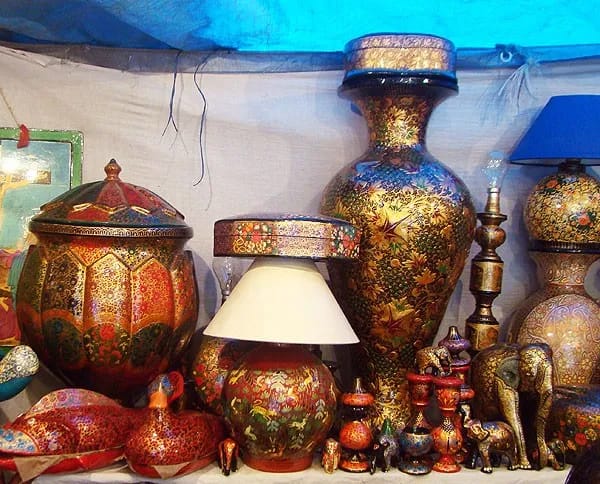
Papier Mache is one of the most popular crafts practised in Kashmir. The tradition of the Kashmir Papier Mache has its origin rooted in the 15th century when King Zain-ul-Abidin invited accomplished artists and craftsmen from Central Asia.
A French term so commonly adopted in East and West and meaning “mashed paper”, papier machine is a unique combination of line and colour on moulded forms of a variety of objects. It involves ornamentation in colour over smoothened surfaces built up of paper pulp or layers of paper.
The origin of hand-knotted carpets, locally known as “Kal baffi,” dates back to the 15th century, after which it progressively attained a high degree of perfection. It is said that Sultan Zain-ul-Abidin brought carpet weavers from Persia and Central Asia into Kashmir to train the local inhabitants.
The Music And Folk Traditions Of Kashmir
Jammu and Kashmir have deep musical roots. Kashmiri music embodies the state’s melodic heritage and refined inheritance. In addition, the state has a long history of traditional musical instruments that have become the soul of Kashmiri music.
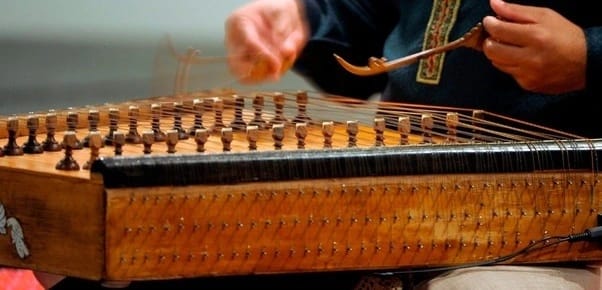
The Indian Santoor is a trapezoid-shaped hammered dulcimer. It is a variant of the Iranian Santur. The instrument is made primarily of walnut and has 25 bridges. Each bridge has four strings, for a total of 100.
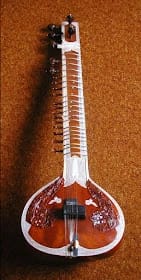
Next in our Kashmiri musical instruments list is the Sitar. Sitar is a plucked lute with a long neck, similar to the Persian Sitar. According to Curt Sach, the Arabs refer to it as the largest variety. Tanbur Kabir Turki, also known as a large Turkish lute.
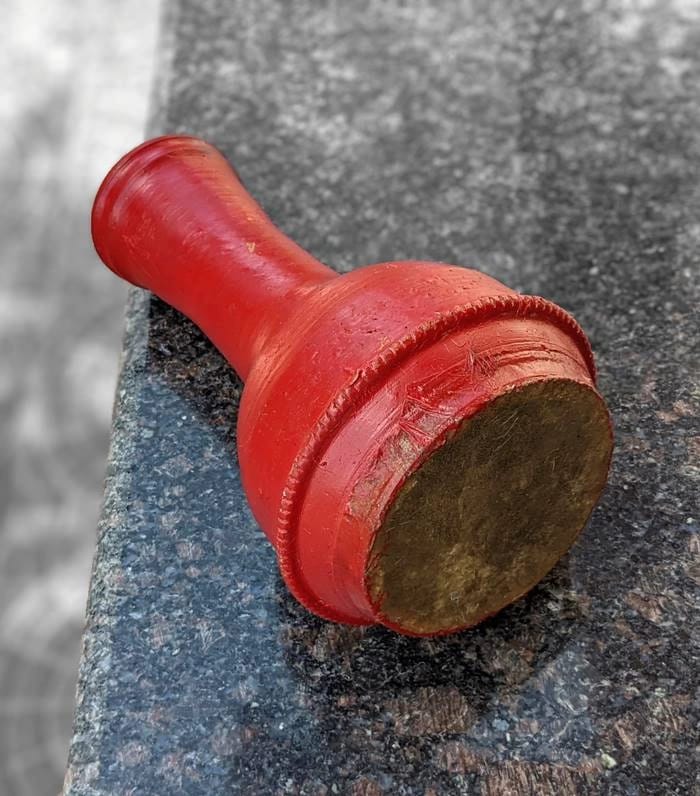
Tumbaknari is an earthen-shaped instrument used for singing at all Kashmiri functions, particularly weddings. The instrument is thought to have originated in Iran. Tumbaknari is typically played by women at weddings in the valley, and weddings are incomplete without it.
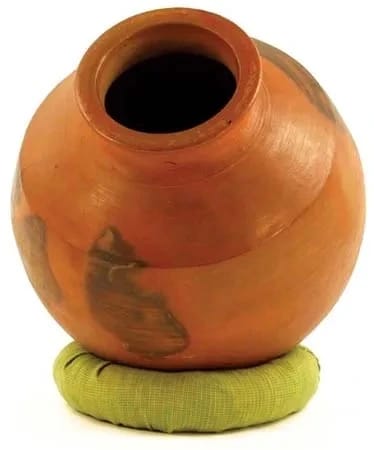
The Noet is the most ancient type of drum variety known to mankind. The shape of the Noet of Kashmir is similar to the Ghatam of South India or the Matki of Rajasthan. They are used as instruments in music in those states. Thus indicating that they may have started their journey from the same cultural background.
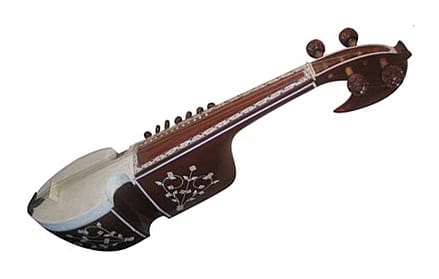
Rabab is an essential component of Kashmiri music culture. It’s made of second-growth mulberry wood. It measures about three and a half feet long. Rabab is usually performed in the form of songs at special occasions and weddings.
Historic Places and Architecture In Kashmir
The traditional buildings are of two types based on plan- square plan and linear plan, having windows on all sides, and the arrangement of function inside the house is distributed in symmetry, as symmetry is the basic principle for earthquake-resistant structures. Each house has a Zoon Dub or a cantilevered balcony designed for the viewing of the moon (zoon).
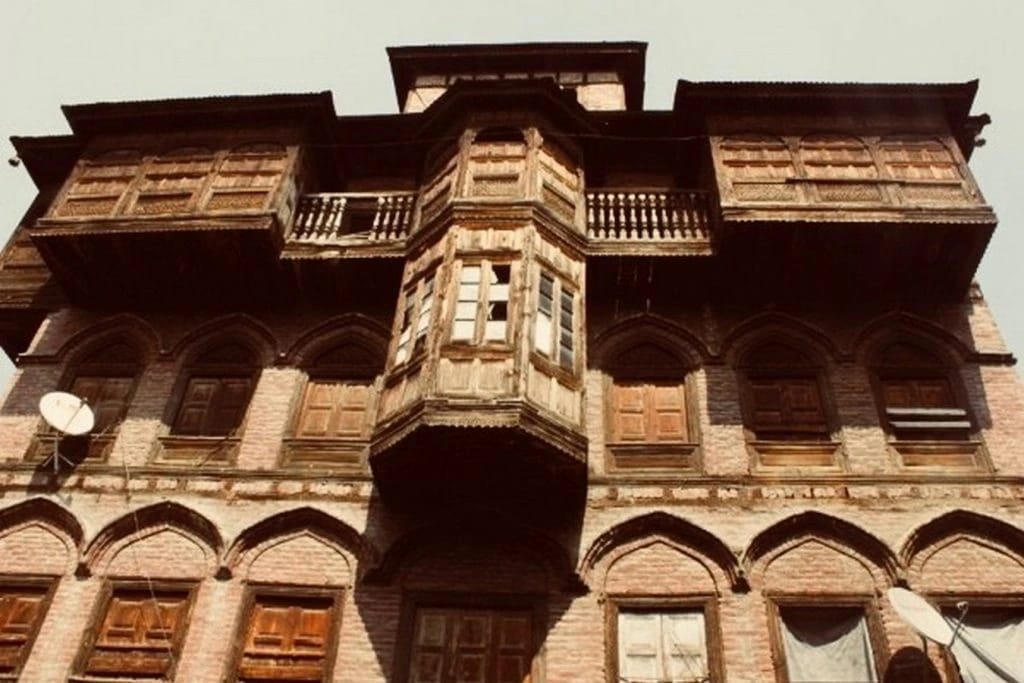
The balconies and the eaves have beautiful PinjaraKari work and wooden wind chimes shaped like jhumkas. The interior roofs have wooden false ceilings of khatamband panels of interlocking geometric shapes derived from the Persian arts and are made up of walnuts or deodar with visible joinery.
Based on the construction techniques, traditional houses in Kashmir are divided into two categories—Taq construction and Dhajji Dewari. Dhajji De
wari consists of wooden frames and trusses filled with flat stones or bricks, and is packed neatly into the gaps with mud or lime mortar, and the remaining gaps are filled with stone flakes. To increase the strength and to secure the stones against falling out, wire mesh is nailed to both sides of the wall, and the wall is then plastered using mud or cement.
Mughal gardens in Kashmir will be incomplete without the mention of Shalimar Bagh. Shalimar, literally translating to ‘the abode or hall of love,’ is an alluring garden built by the Mughal emperor Jahangir for his wife, Noor Jahan. The garden has three terraces, with pools, fountains, and trees on the edges of each terrace. The lush garden is the epitome of natural beauty and tranquillity.
Translating to ‘garden of delight’ or ‘garden of joy’, Nishat Bagh is exceptionally beautiful and incredibly artistic. This second-largest Mughal garden in Srinagar is located on the eastern side of Dal Lake. It is divided into 12 terraces (representing the 12 zodiac signs), adorned with flowerbeds and fountains. With the Persian design concept, exceptional Mughal architectural style, and mesmerising landscape, Nishat Bagh will treat your senses.
Social Customs And Values In Kashmiri Society
Examples of Kashmiriyat cannot be found anywhere else in India because the essence of humanity present in Kashmir is unique.
In my opinion, Kashmiriyat can be understood through the human nature of the people in Kashmir. The best examples can be found in how any outsider, whether known or unknown, is treated as a guest of honour. People in Kashmir respect their guests like God. Kashmiri people are known for their hospitality without any discrimination based on caste, colour, or religion.
This unique quality is often highlighted by those who have visited Kashmir. The first thing tourists and visitors say about Kashmir is, “Kashmiri log mehman-nawaz hain” (Kashmiri people are hospitable). Kashmiris are gentle, sober, and noble, living harmoniously alongside people of other religions.
Kashmiriyat has been characterized by a strong tradition of hospitality, where guests are treated with utmost respect and care. This hospitality is a manifestation of the underlying humanity that defines the region’s cultural ethos. Even during times of conflict and violence, many Kashmiris have continued to uphold these values, offering protection and assistance to those in danger, regardless of their background.
This unwavering commitment to humanity is a testament to the enduring spirit of Kashmiriyat, which seeks to transcend divisions and foster a culture of compassion and unity. Kashmiriyat is a secular social fabric of the people living in Kashmir, where individuals, regardless of caste, colour, or creed, demonstrate deep mutual care and support.
Conclusion
Kashmir’s cultural heritage is a tapestry woven from its history, crafts, festivals, and cuisine, each thread revealing a facet of the region’s rich identity. As you journey through Kashmir, you’ll encounter its impassioned traditions and timeless artistry at every turn, offering a profound and immersive experience. This remarkable blend of elements makes Kashmir not just a destination but a captivating exploration of a culture that continues to enchant and inspire.

